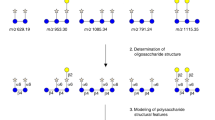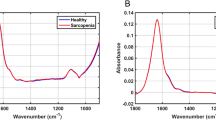Abstract
MIXTURES of monosaccharides derived from complex polysaccharides often present difficulties in identification when the compounds migrate close to one another on paper chromatograms. Difficulties of this kind have been encountered with certain bacterial polysaccharides containing glucose, galactose and heptoses. With the use of the glucose oxidase1-indicator reagent, ‘Glucostat’ (Worthington Biochemical Corporation) it has been possible to locate specifically the glucose and then reveal other monosaccharides on the same paper chromatogram.
This is a preview of subscription content, access via your institution
Access options
Subscribe to this journal
Receive 51 print issues and online access
$199.00 per year
only $3.90 per issue
Buy this article
- Purchase on Springer Link
- Instant access to full article PDF
Prices may be subject to local taxes which are calculated during checkout
Similar content being viewed by others

References
Keilin, D., and Hartree, E. F., Biochem. J., 42, 230 (1948).
Teller, J. D., Abstract of Papers, 130th Meeting, Amer. Chem. Soc., 69, C (Sept. 1956). Huggett, A. St. G., and Nixon, D. A., Lancet, ii, 368 (1957). Saifer, A., and Gerstenfeld, S., J. Lab. and Clin. Med., 51, 448 (1958).
Cooper, J. A. D., Smith, W., Bacila, M., and Medina, H., J. Biol. Chem., 234, 445 (1959).
Author information
Authors and Affiliations
Rights and permissions
About this article
Cite this article
SALTON, M. Specific Detection of Glucose on Paper Chromatograms. Nature 186, 966–967 (1960). https://doi.org/10.1038/186966b0
Issue Date:
DOI: https://doi.org/10.1038/186966b0
This article is cited by
-
Regulators of cell division in plant tissues
Planta (1974)
-
Oligosaccharides containing Glucose as Substrates for Hen's Egg White Lysozyme
Nature (1968)
-
Composition of lipopolysaccharides fromRhizobium andAgrobacterium
Antonie van Leeuwenhoek (1968)
Comments
By submitting a comment you agree to abide by our Terms and Community Guidelines. If you find something abusive or that does not comply with our terms or guidelines please flag it as inappropriate.


